Margie and Bix
By Albert Haim
The Composition.
Margie was composed by Con Conrad (music), Benny Davis (lyric), and J. Russell Robinson (music) in 1920, and published by the Waterson, Berlin and Snyder Music Publishing Company.
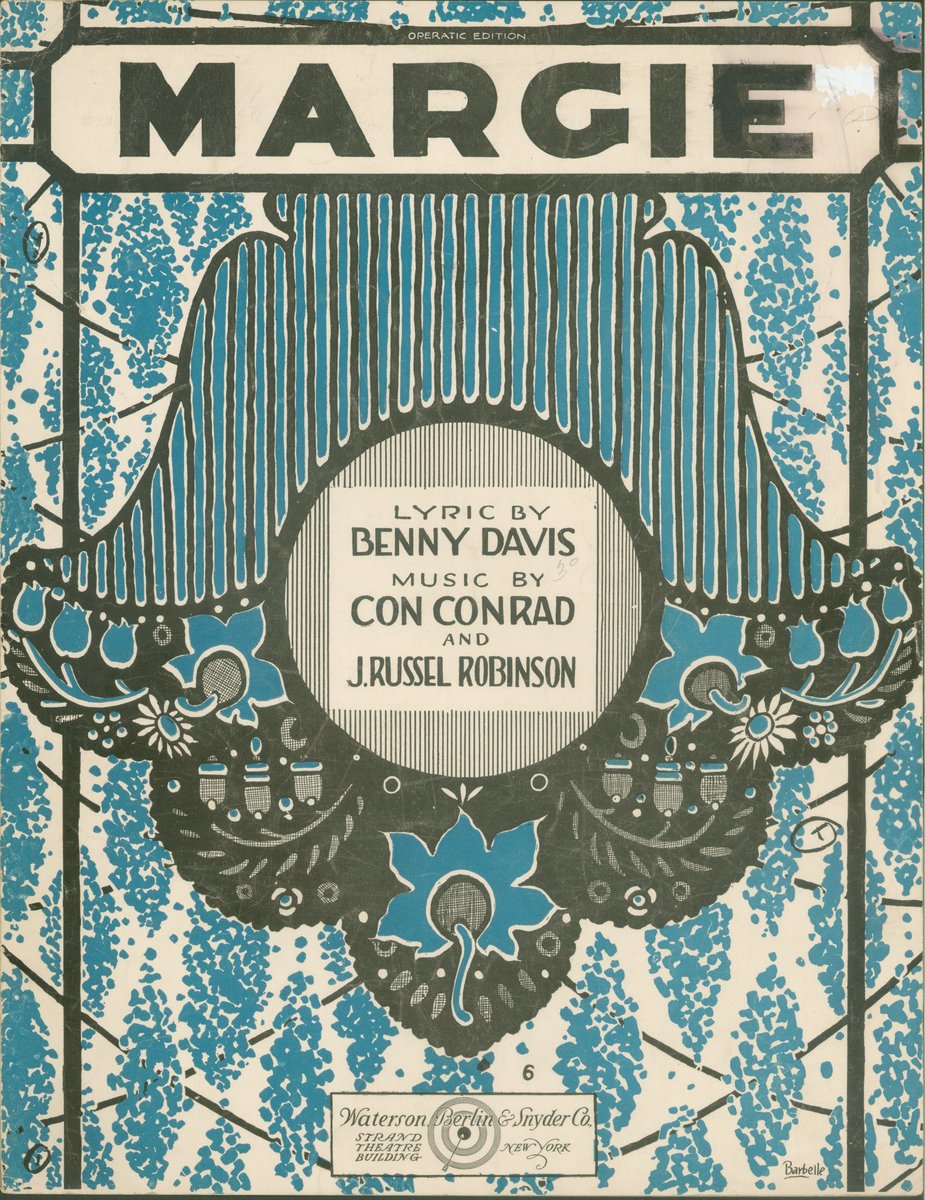
Courtesy of the Indiana University Sheet Music Collection.
It will be seen that the illustation on the cover is by Barbelle. Albert W. Barbelle was an artist and sheet music illustrator active from the 1910s into the 1940s.
According to several accounts [Note 1], Margie was inspired by Eddie Cantor's five -year old daughter, Marjorie. In the Fall of 1920, Eddie Cantor was appearing in the Broadway Brevities of 1920 in the Winter Garden Theatre, in New York City, and sang the tune on a Sunday evening concert in November. Later, [Note 2] he interpolated Margie in the Midnight Rounders of 1921. Cantor describes this in his autobiography, "And there was Con Conrad, best known for The Continental. For me he wrote the music for Lena, She's the Queen of Palesteena, and Ma, He's Making Eyes at Me, and Barney Google, and -Margie, which I sang first on a Sunday night at the Winter Gardens and then took into the Midnight Rounders. Con wrote Margie with Benny Davis and J. Russell Robinson and the minute they finished it they brought it over to "plug" to me because I had a daughter named Marjorie." [Note 3]
Margie was used as the music for Dave Fleischer's 1926 animated short fim of the same name. The song was also featured in the soundtrack of several films: Young Bride (1932); Stella Dallas (1937); Turnabout (1940); Incendiary Blonde (1945); Margie (1946); The Eddie Cantor Story (1953); The Cat's Meow (2001).
The Composers.
Con Conrad was born in New York City in 1891 and died in Van Nuys, California in 1938. His real name was Conrad K. Dober. His first job, at 16, was in a Harlem movie house as piano accompanist to silent films. In 1913, Conrad produced the Broadway show "The Honeymoon Express" starring a young, and little known at the time, Al Jolson. In 1918, Conrad focused his career on professional song writing. His first big success was Margie. In the mid twenties, Conrad wrote music for several Broadway shows, The Greenwich
Follies, 1923, Moonlight, 1924, Kitty’s Kisses, 1926 and Americana, 1926-1927. Conrad moved to Hollywood in 1929 and wrote songs for films. In 1934 he collaborated with lyricist Herb Magidson in writing songs for Fred Astaire's and Ginger Rogers' 1934 film "The Gay Divorcee." One of the songs, The Continental was the first song to receive an Academy Award for Best Song. Conrad was inducted in the Songwriters Hall of Fame in 1970.
Benny Davis was born in New York City in 1895 and died in Miami, Florida in 1979. At the age of 14, he started his musical career as a vaudeville artist. From 1920 on, he was a professional songwriter. His first hit was Margie. Other highly successful songs followed, Carolina Moon, Baby Face, Lonesome and Sorry, Angel Child. Davis wrote the scores for several Broadway shows in the 1920s, Artists and Models of 1927, Sons o' Guns and several editions of the Cotton Club Revues. He was inducted in the Songwriters Hall of Fame in 1975.
J. Russell Robinson was born in Indianapolis, Indiana in 1892 and died in Palmdale, California in 1962. Robinson was a ragtime and jazz pianist and composer. In the 1910s, he toured the South and played in New Orleans with his brother who was a drummer. Robinson was advertised as the "white boy with the colored fingers." Robinson joined the Original Dixieland Jazz Band in 1919 and went to England with them. In the 1920s he accompanied several female singers, Marion Harris, Lucille Hegamin, Lizzie Miles, and Annette Hanshaw. Robinson then devoted himself to composing. Some of his compositions are Eccentric, Sapho Rag, Singin' the Blues, Palesteena, and Mary Lou. He also wrote the title song for the 1948 film Portrait of Jennie.
Recordings.
There were numerous recordings of the tune in late 1920. Margie was first recorded by [Milo] Rega's Novelty Band in October 1920 and issued as OKeh 4211. It was an instrumental version. The tune was next recorded, also as an instrumental, by Al Jocker's Dance Orchestra in November 1920 and issued as Vocalion 14137; this record included an introduction to You Oughta See My Baby, another Conrad and Robinson tune. The Original Dixieland Jazz Band recorded Margie on November 24, 1920. Four takes were waxed, but none was issued. The ODJB recorded the tune again a week later, December 1, 1920. Take 5, an instrumental version, was issued as Victor 18717, and included an introduction to Singin' the Blues, another tune composed by Conrad and Robinson. [Note 4] Ted Lewis and His Band had recorded a few days earlier, on November 28, 1920 , two takes of the same tune. Take 2 was issued as Columbia A3351, also an instrumental version. Interestingly, Ted Lewis recorded on the same day, November 28, 1920, three takes of the tune with a vocal by Ted Lewis and Benny Davis, but all takes were rejected. Also in November 1920, another instrumental version was recorded on Emerson 10295 by the Plantation Jazz Orchestra, a group led by trombonist Harry Raderman. The first recordings of the tune that included a vocal were waxed in December 1920 by [Ben] Selvin's Novelty Orchestra on Arto 9047 with Arthur Hall as vocalist and by Eddie Cantor for Emerson 10301.
Except for a recording in 1922 by Argentina's Orquesta Yribarren American Jazz Band, there was long hiatus -no recordings of Margie until 1928. Then, within a few months, Margie was recorded by Red Nichols and His Five Pennies, June 1, 1928, Brunswick 3169, and by Bix Beiderbecke and His Gang on September 21, 1928. This recording was not issued until 1942. This will be discussed below.
There were about two dozen recordings of Margie in the 1930s, more than 30 in the 1940s, and the popularity of the tune continued unabashed with tens of recordings from the 1950s into the 21st century. Noteworthy artists who recorded Margie in the 30s to 50s decades are (in chronological order) Duke Ellington, Cab Calloway, Benny Goodman, Jimmie Lunceford [with James "Trummy" Young on trombone and vocal, an important hit in 1938], Don Redman, Mary Lou Williams, the Casa Loma Orchestra, Tommy Dorsey, Stephane Grappelli, Cliff Edwards, Bunk Johnson, Earl Hines, Gene Krupa, Frank Signorelli, Ray Anthony, Oscar Peterson, Kid Ory, George Wettling, Harry James, Sidney Bechet, Errol Garner, Django Reinhardt, Louis Armstrong, George Lewis, Dick Hyman, Sy Oliver, Fats Domino, Ray Charles (1960).
The Last Recording Session of Bix and His Gang. Margie.
On September 21, 1928 Bix Beiderbecke went to the OKeh studios for his last recording session as "Bix Beiderbecke and His Gang." The first recording session of Bix Beiderbecke and His Gang had taken place less than a year earlier on October 5, 1927. The musicians in the first band were Bix's mates in Adrian Rollini's short-lived Club New Yorker Band, Bill Rank, Don Murray, Frank Signorelli, Adrian Rollini, and Chauncey Morehouse. Three legendary sides were waxed in that session, At the Jazz Band Ball, Royal Garden Blues, and The Jazz Me Blues. In the liners for the Mosaic set "The Complete Okeh and Brunswick Bix Beiderbecke, Frank Trumbauer and Jack Teagarden Session (1924-1936)," Richard Sudhalter writes, "It's hardly stretching things to suggest that the three titles done at Bix's debut OKeh session with his "Gang" constitute the birth of what later became known as jazz repertory: an act of homage to an earlier group through performance of numbers they helped make famous, in at least an approximation of their style." Oddly, Royal Garden Blues, OKeh 8544 was issued under the name of "The New Orleans Lucky Seven," although there were only six musicians in the band. The other two titles were issued under the name of "Bix Beiderbecke and His Gang."
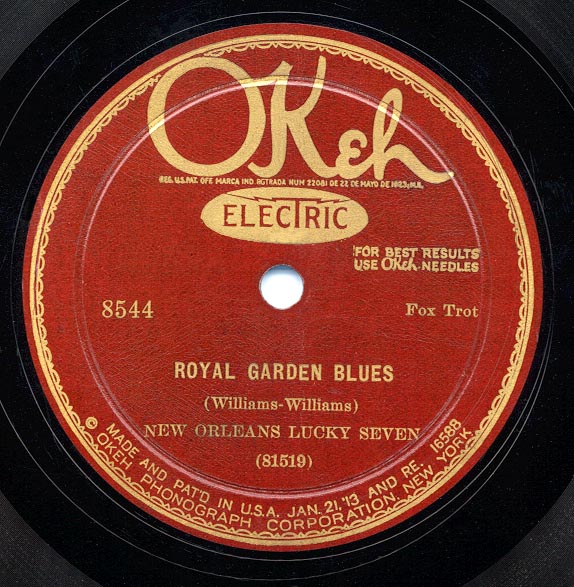
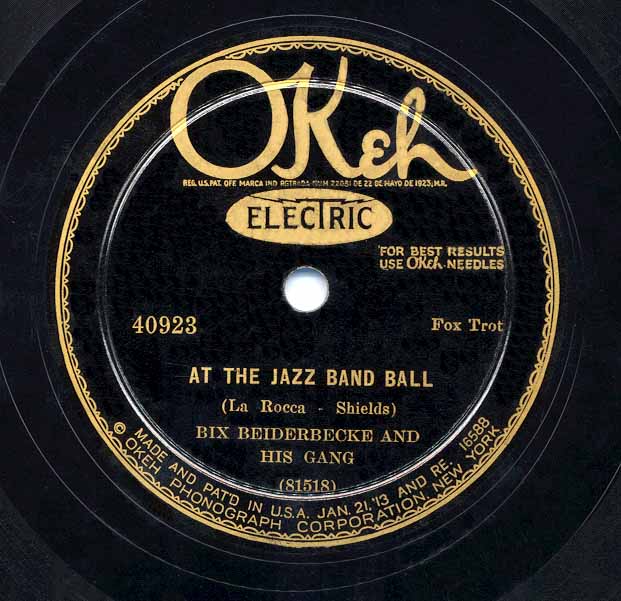
Courtesy of the Bixography Website Courtesy of the Bixography Website
Three sides were reccorded by Bix and His Gang on September 21, 1928, Rhythm King (Trent and Robinson), Louisiana (Razaf, Schafer and Johnson), and Margie (Davis, Conrad, and Robinson). As was the case for the tunes waxed in the first recording session of Bix and his Gang, Margie is a return and a tribute to the music of the Original Dixieland Jazz Band. In September 1928, Bix was a member of the Paul Whiteman Orchestra. Therefore, the musicians in the Gang were from Whiteman's band, Bill Rank, Irving Friedman, Roy Bargy, Min Leibrook, and Lennie Hayton. The absence of a drummer and the presence of two pianists are conspicuous. Apparently, the relationships between Bix and George Marsh, Whiteman's drummer at the time, were somewhat strained. [Note 5] The first two sides were released on February 5, 1929, OKeh 41173.
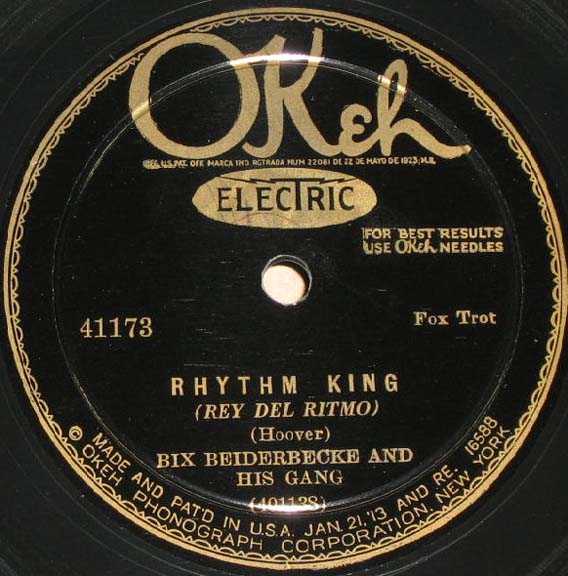
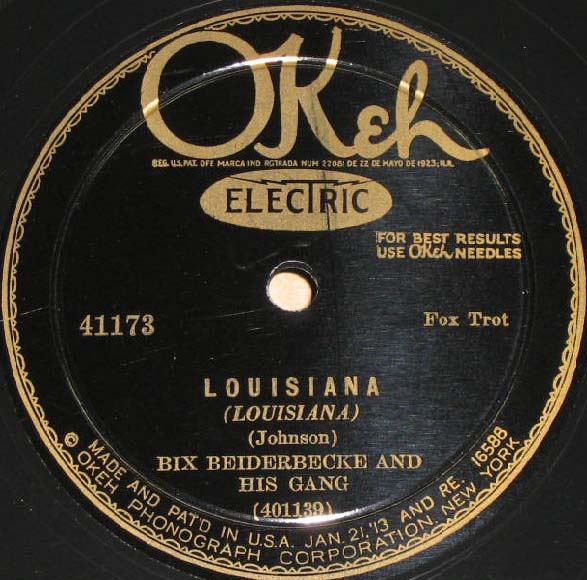
Courtesy of the Bixography Website Courtesy of the Bixography Website
Curiously, the first release of Margie was in England in 1942! I have not found why the record was not released in 1928-1929. The quality of the recording seems adequate and there are no "bloopers." Margie was issued on February 1, 1942 in the Parlophone Jazz Classics Series as by Bix Beiderbecke and His Orchestra. The record was also mastered by Italian Parlophone.

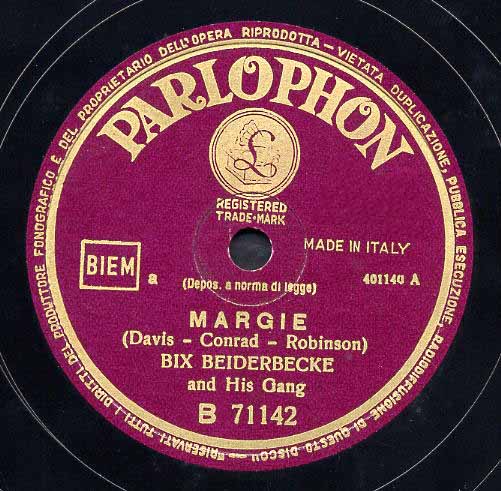
Courtesy of Norman Field Courtesy of Enrico Borsetti
A very interesting article entitled "War Time Britain Scoops The Jazz World. Unknown Bix and Gang Disc Discovered. Elliott and Traill on The Trail" was published in the December 6, 1941 issue of "The Melody Maker and Rhythm." There is a detailed account of how the master for Margie was searched and found by Sinclair Traill and Bill Elliott. Trail and Elliott realized that the last Bix and His Gang record known at the time was Louisiana, matrix number 401139. They had a "hunch that maybe other titles were made [by Bix] during the same period" and asked Wally Moody [Note 6] to search for "some old OKeh masters." Sinclair Traill's tells the story, "It was Thursday, November 27, and I was due to report to the R.A.F. the following day. Bill and I had gone up to see Wally Moody at Abbey Road for me to make my adieus to him. We chatted of this and that, and just as we were leaving-Bill was half-way down the stairs-when Wally said, 'By the way, here's a list of those Okeh titles you wanted.' " On their way home, after seeing Margie by Bix and His Gang in the list, they called Moody and asked him to provide a test pressing. On Friday, November 28, Elliott played the record over the telephone to Traill. Traill continues his account, "It was all we had hoped for and more. Bix Beiderbecke (cornet); Bill Rank (trombone); Izzy Friedman (clarinet); Min Leibrook (bass sax); Lenny Hayton (piano); George Marsh (drums). Two solos from Bix, one from Friedman and one from Hayton-a typical Bix and His Gang on Okeh Matrix No. 401140." [Note 7]
Conclusion
The finding in late 1941 of Margie, an unknown (at the time) Bix record, was a remarkable a discovery. Other late and important findings of Bix recordings are alternate takes of Thou Swell (1977), My Pet (2003), Futuristic Rhythm (2005), Raisin' the Roof (2005),

Label of Test Pressing of Raisin' the Roof
Courtesy of Michael Kieffer and Origin Jazz Library
and Ol' Man River (2005). The recordings waxed at the June 6, 1930 session of Irving Mills and His Hotsy Gang (Loved One, Deep Harlem, and Strut Miss Lizzie) were not recognized as genuine items at the time they were released: it took more than 40 years to ascertain that Bix was indeed the cornetist who played in the records. The quest for hitherto unknown Bix recordings and/or alternate takes of known recordings continues.
Acknowledgment. I am grateful to Nick Dellow for a copy of the article in the "Melody Maker and Rhythm."
[Note 1] For example, "The Jazz Age: Popular Music in the 1920s." by Arnold Shaw, Oxford University Press, 1989; "All the Years of American Popular Music: A Comprehensive History" by David Ewen, Prentice-Hall, 1977.
[Note 2] "Popular Music, Vol. 5, 1920-1929." edited by Nat Shapiro, Adrian Press, Inc., 1969.
[Note 3] "Take My Life" by Eddie Cantor with Jane Kresner Armore, Doubleday, 1957.
[Note 4] A little over six years later, on February 4, 1927, cornetist Bix Beiderbecke with Frank Trumbauer's Orchestra recorded the definitive version of Singin' the Blues, OKeh 40772.
[Note 5] Albert Haim, "Drummers in the Recordings of Frank Trumbauer and His Orchestra and Bix Beiderbecke and His Gang 1927-1929: An Anomaly and a Hypothesis." IAJRC Journal, Vol. 37, No. 2, Spring 2004.
[Note 6] Wally Moody was an employee of the Gramophone Company (EMI).
[Note 7] The roster of musicians is given by Sudhalter and Evans in "Bix: Man and Legend," by Evans and Evans in "Bix: The Leon Beiderbecke Story," by the research team (Richard Sudhalter, Scott Wenzel, Michael Brooks, Dan Morgenstern, Mike Peters, Dave Sager, Loren Schoenberg, Joe Showler) for the Mosaic set on Bix, Tram and Teagarden, by Jean Pierre Lion in "Bix, The Definitive Biography of A Jazz Legend" and by Brian Rust in "Jazz and Ragtime Records." The information in the Mosaic set is based in addition on the original OKeh file cards located in Sony's New York archives. There is little doubt that the drummer in Margie is Lennie Hayton, not George Marsh. Sudhalter in the Mosaic booklet, "There is no drummer-at least no official one. Research places Roy Bargy at the keyboard, and fellow pianist Lennie Hayton at a jury-rigged drum kit." "From all recollections Bix worked out a simple, functional four-bar intro, and they jammed the rest with Hayton pounding away happily-if without noticeable finesse-on the drums.